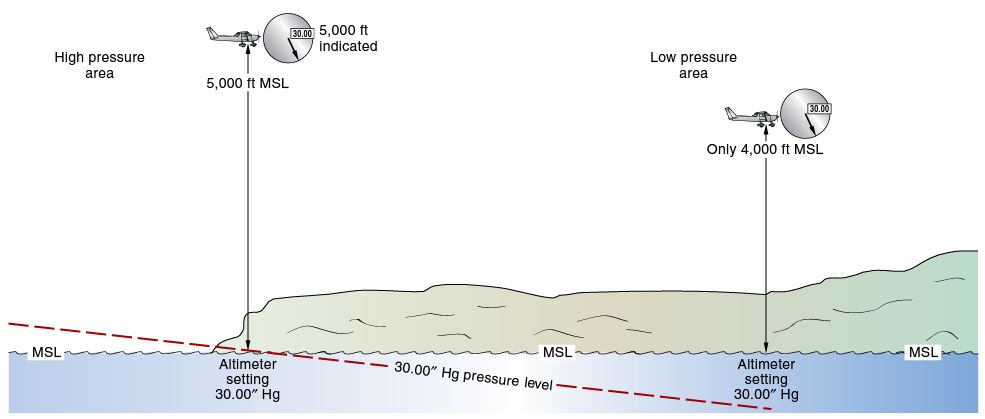High to low look out below, low to high clear the sky! If you have never heard that saying before you are probably pretty confused right now. Let me help ease that confusion and explain that today we are discussing altimeter errors when flying in areas of changing atmospheric pressures. The discussion will revolve around two specific Private Pilot Knowledge Test questions that I get calls about regularly. These questions outline common areas that trip students up, resulting in mass confusion.
1. If a flight is made from an area of low pressure into an area of high pressure without the altimeter setting being adjusted, the altimeter will indicate
A. the actual altitude above sea level.
B. higher than the actual altitude above sea level.
C. lower than the actual altitude above sea level.
2. If a flight is made from an area of high pressure into an area of lower pressure without the altimeter setting being adjusted, the altimeter will indicate
A. lower than the actual altitude above sea level.
B. higher than the actual altitude above sea level.
C. the actual altitude above sea level.
If you answered B an A, respectively, then you are also having some of the same confusion about this topic that many other students experience. Let’s start with the knowledge required to answer these questions.
It is easy to maintain a consistent height above ground if the barometric pressure and temperature remain constant, but this is rarely the case. The pressure and temperature can change between takeoff and landing on a local flight and even more drastically when flying cross country between areas of varying pressure and temperature. If these changes are not taken into consideration, flight becomes dangerous.
For example, when flying from an area of high pressure to an area of low pressure without adjusting the altimeter, a constant indicated altitude will remain but the aircraft’s actual altitude above ground level will be lower than indicated. Conversely, when flying from an area of low pressure to an area of high pressure the aircraft’s actual altitude above ground level will be higher than the indicated altitude on the altimeter. The image below is a good visual depiction of flying from an area of high pressure to an area of low pressure and the resulting altitude of the aircraft above the ground level if the altimeter is not adjusted. 
The reason so many students answer these questions incorrectly is not so much because they don’t understand the principle knowledge, but rather because they are not understanding what the question is asking. Both questions are asking what the ALTIMETER will indicate, not what the aircraft’s actual altitude is relative to the ground.
The correct answer to question 1 is C: the altimeter will indicate lower than the actual altitude above sea level. When flying from a low pressure area into a high pressure area the aircraft’s altitude will slowly increase while the altimeter remains constant; therefore, the ALTIMETER is indicating a LOWER altitude then what the aircraft is actually flying.
Vice versa, the correct answer to question 2 is B: the altimeter will indicate higher than the actual altitude above sea level. When flying from a high pressure area into a low pressure area, the aircraft’s altitude will slowly decrease while the altimeter remains constant therefore the ALTIMETER is indicating a HIGHER altitude then what the aircraft is actually flying.
Tricky questions yes, but also a very important piece of knowledge to fully understand. You should now be able to correctly answer these on your knowledge test as well as remember to adjust the altimeter when flying between different air pressure systems.




